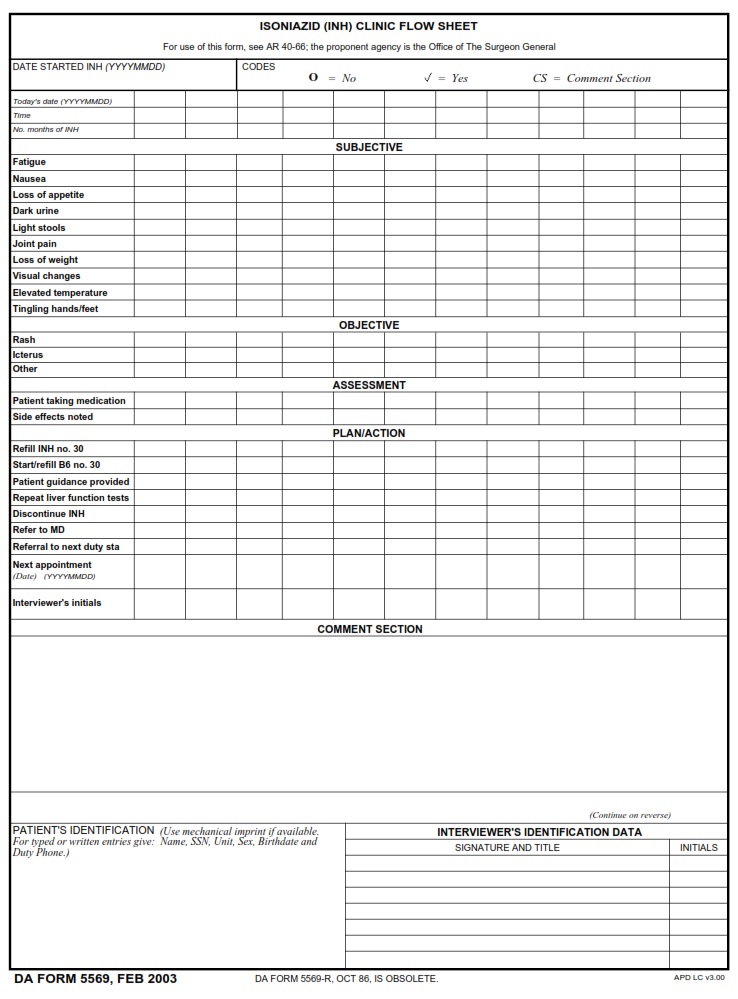Table of Contents
FREE-ONLINE-FORMS.COM – DA Form 5569 – Isoniazid (INH) Clinic Flow Sheet – Imagine a bustling clinic, filled with the whispers of medical professionals and the hushed murmurs of patients seeking care. In the midst of this organized chaos lies a humble form – DA Form 5569, known to many as the Isoniazid (INH) Clinic Flow Sheet. This seemingly unassuming document holds within its rows and columns a wealth of crucial information that guides healthcare providers in the management and monitoring of patients undergoing treatment for tuberculosis. As we dive into the intricacies of this form, we unravel a narrative of precision, collaboration, and dedication to improving patient outcomes in the realm of infectious disease control. Join us on a journey through the corridors of healthcare excellence as we explore how this simple sheet transforms into a beacon of hope for those battling one of humanity’s oldest foes – tuberculosis.
Download DA Form 5569 – Isoniazid (INH) Clinic Flow Sheet
| Form Number | DA Form 5569 |
| Form Title | Isoniazid (INH) Clinic Flow Sheet |
| Edition Date | 2/1/2003 |
| File Size | 69 KB |
What is a DA Form 5569?
The DA Form 5569 is a crucial document used in Isoniazid (INH) clinics to monitor and track the progress of patients undergoing treatment for tuberculosis. This form serves as a flow sheet that captures essential information such as the patient’s name, age, weight, and INH dosage schedule. By documenting these details on the DA Form 5569, healthcare providers can ensure accurate administration of INH medication and proper monitoring of patient responses.
Moreover, the DA Form 5569 allows healthcare professionals to maintain a comprehensive record of each patient’s INH therapy journey. Tracking important indicators like liver enzyme levels and adverse reactions enables medical personnel to make timely adjustments to treatment plans if necessary. Ultimately, the meticulous documentation facilitated by the DA Form 5569 plays a significant role in optimizing patient care and promoting successful outcomes in tuberculosis management.
Where Can I Find a DA Form 5569?
If you are in search of a DA Form 5569 for your Isoniazid (INH) Clinic Flow Sheet needs, there are several avenues where you can access this important document. One of the most convenient ways is through official military channels, such as the U.S. Army Medical Department Forms website or your unit’s administrative office. Additionally, many online resources offer downloadable versions of DA Form 5569 for easy access and printing.
For those who prefer a more hands-on approach, local military installations often have physical copies of DA Form 5569 available at medical clinics or administrative offices. This option allows for immediate access to the form without relying on digital platforms. No matter which route you choose to obtain a DA Form 5569, ensuring that you have the necessary paperwork for your Isoniazid (INH) Clinic Flow Sheet is essential for maintaining accurate healthcare records and providing quality patient care.
DA Form 5569 – Isoniazid (INH) Clinic Flow Sheet
The utilization of DA Form 5569, the Isoniazid (INH) Clinic Flow Sheet, serves as a pivotal tool in effectively managing and monitoring patients undergoing treatment for tuberculosis. This comprehensive form streamlines the process by documenting crucial information such as patient demographics, INH dosing schedule, liver function tests, and other pertinent details essential for tracking progress and ensuring successful outcomes. By structuring clinical workflows through this form, healthcare providers can enhance the coordination of care and facilitate proactive interventions to mitigate potential complications.
Moreover, the incorporation of the DA Form 5569 empowers healthcare professionals to implement evidence-based approaches in monitoring patient response to Isoniazid therapy. Regular assessments recorded on this flow sheet guide medical decisions regarding dose adjustments, adherence monitoring, and side effect management. In essence, this tool not only optimizes clinical efficiency but also underscores the importance of personalized care tailored to individual patient needs throughout the course of tuberculosis treatment.
